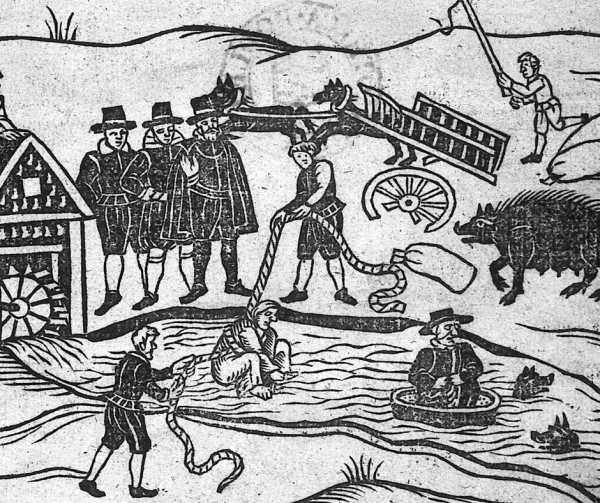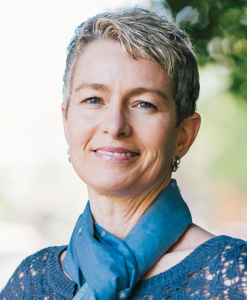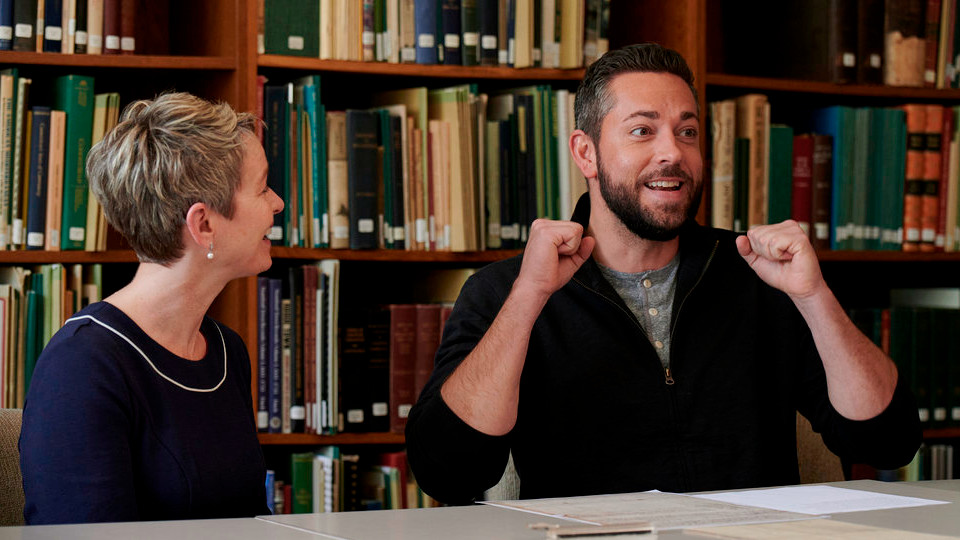
Welcome to Colorado State University’s new podcast, The Audit, featuring conversations with CSU faculty on everything from research to current events. Just as auditing a class provides a fun way to explore a new subject or field, The Audit allows listeners to explore the latest works from the experts at CSU.

In 2022, witches are seen as a fun and fantastical novelty, especially around this time of year when the Halloween season has us dressing up in costumes and watching movies like “Hocus Pocus.” But back in the 1600s, it was a decidedly different story where witches were seen as neither fun nor fantasy, but a real threat to society.
Audit host Stacy Nick recently spoke with Colorado State University Professor Ann Little, an expert on early North American history, specializing in the history of women, gender, and sexuality, about our fascination with the witch trials from that time and what a modern-day witch hunt could look like.
At one point during the 1600s, witchcraft was seen as a genuinely dangerous thing.
Yes, witches were considered demonic, possessed by the devil, and they possessed all manner of supernatural powers.
How did that belief evolve?
Well, people in the early modern era, people in the Renaissance era, in the 16th and 17th centuries truly believed that the world was alive with both good magic — white magic — and bad magic — black magic. They believed that God and the devil were presences in their lives, and they believed in an interventionist, both God and devil at the time. So, people really, truly believed that demonic forces, the diabolical forces, supernatural forces, could influence everyday life and everyday mundane activities on Earth.
Women were particularly targeted. What were some of the most common reasons given for charging a woman as a witch?
Women were targeted because they were not people who were supposed to possess very much earthly power. It was the suspicion that they were channeling some kind of demonic force, that they were possessed by the devil, that they were channeling some kind of demonic power that led them to be accused of witchcraft. And this power that people suspected these women were illicitly and illegitimately attempting to wield was manifest in any number of everyday occurrences: the death of a child, especially a very young child; the failure of a pan of cream to turn to butter at the right time; the failure of a cheese to set; the failure of cattle or chickens to thrive. All kinds of everyday occurrences could lead to a an individual — specifically a woman — to be accused of witchcraft.

That seems so crazy that any natural thing, anything that we know now is just a regular occurrence, could lead to being accused of witchcraft. That had to be very stressful.
I think it was. I mean, it wasn’t every woman all the time being accused constantly of witchcraft. Right. We know that these crazes, these outbreaks, would happen at particularly volatile or vulnerable cultural moments. Historians disagree about the causes of witchcraft, as well as the reason that it eventually faded away. But most historians seem to believe that it was a combination of the Protestant Reformation, the age of religious wars, the Gutenberg press — that is, the greater literacy and materials for reading that helped lead to the witchcraft era — plus the fact that this was an era, again, in European history, at a time in which Europe was convulsed with religious warfare. So, in a sad cycle that I think our friends in Ukraine are going to be realizing this winter, warfare is a stalking horse for both famine and disease. Warfare is something that happens during the planting and growing season, during the summer season in the northern hemisphere. If you can’t get your crops in the ground because you’re out soldiering around or your town is vulnerable to being attacked and burned by the enemy, you don’t have time or energy to get your crops in the ground. If you do, you can’t get them out of the ground because they’ve been burned or destroyed. That kind of nutritional insufficiency can lead to disease. So, warfare, famine, disease – they’re all these interrelated phenomena that left a lot of people, especially in very war-torn regions like Central Germany in the 16th century and even parts of England in the 16th and 17th centuries, as being very vulnerable. People were very worried about their ability in these little agricultural villages to provide enough food for themselves and their families.
When a woman would be charged with being a witch, was there anything that she could do? How do they defend themselves or could they defend themselves?
This varies according to when somebody is accused of witchcraft, whether it’s going to become a craze or not. Europe executed probably tens of thousands of individuals, most of whom were women, over these accusations. In North America, it wasn’t nearly as high of a body count. Even if we include the witchcraft accusations in some of the Spanish colonies down in the southwest of what’s now the United States. But, for example, in a case I know of in Connecticut, a woman was accused of witchcraft and her husband gathered a petition with something like 60 or 70 signatures or marks ascertaining to the truth of what was in the petition, basically testifying that his wife was a good woman who had never troubled herself with any other men’s business and that she should not be executed for witchcraft. So, showing that you have significant community support is a really important thing.
Perhaps we should talk about why somebody would be accused of witchcraft in the first place. It wasn’t just the fact that an individual might have been suspected in the death of a child or in the death of domestic livestock or in what we would see now as an easily explainable natural phenomenon. But that would have been unfortunate and potentially life threatening for the individuals who saw it or witnessed it, experienced it. The kind of woman who would be accused of witchcraft was overwhelmingly likely to be an older woman. So, a woman, 40 or older, probably post-menopausal. She also was characterized by the phenomenon of being kinless, of not having close family members. Usually, she was a widow if she ever had been married and if she was a widow in the North American context, she likely did not have any male relatives to whom her estate would go after her death. She was characterized by being very alone in the world.
There’s a fascinating British historian named Lyndal Roper, who’s written a number of very persuasive books about witchcraft that I’ve read and that I’ve assigned to my students. She argues that envy is a propelling force in witchcraft accusations, both the envy of the accused — what the accuser sees and the accused — but also perhaps envy as a motivating force in the accusers. So, there’s this phenomenon of the older, disconnected, possibly even a mentally disturbed or angry person. It’s funny, when you read the witchcraft records for early North America in the Anglo-American Colonies, they always talk about witches going about muttering. She was muttering to herself. She’s muttering. Right. Which is, I think, a habit that a lot of older people take on, especially if they live by themselves. They may talk to themselves. Muttering can lead one to suspect you of witchcraft if you’re an older woman. But in any case, this idea of envy, she has something I want, or I have something that she wants. In particular, this seems to revolve around anxieties about fertility and the health of babies and children and the ability of women to conceive and give birth successfully. This idea that an older woman is envious of the fertility and the possibilities that younger women have. This seems to be something that Roper sees a great deal of — she studies Germany — but I think that there’s a lot of applicability to this concept in the English and New England records that I’ve read.
For a long time, I think that the general public has believed that accusing a woman of being a witch during this period of time was a very common event, and that this was also misused or possibly even as a way to punish a woman who maybe stepped out of line or was some way and as you mentioned, kind of othered. There was something that set them apart. And I wondered, is that public perception accurate or have we been maybe led astray by Hollywood, the myth that we have, that we see about the witch trials? How accurate is that?
I think it’s reasonably accurate. How many people executed for a fantasy is too many? I would say one. And I think we moderns can feel sometimes falsely reassured by our belief in science and rationality that we don’t hold these impulses within us any longer in the way that people in the early modern period or the late medieval period did. For years, I resisted teaching courses on witchcraft or even teaching about witches in my early American women’s history courses, because I was frustrated by the dismissive, and I believe arrogant, assumption on the part of students that those people were just crazy, and they were just stupid. And because we’re no longer crazy nor stupid, we’ll never have to face this aspect of humanity again. And I think that that is an arrogant and misguided assumption.
I think today we’re living through a period in which, much like Gutenberg’s technology of the printing press and then mobile type in the 17th century, I think we’re living in a world that is newly enchanted with all kinds of — you can call them demons, you could call them digital fantasies. I think the internet is this fascinating new world where witchcraft thrives. And not just witchcraft under the name of witchcraft, but witchcraft in the guise of strange belief systems that many people are impelled to believe and even impelled to do dramatic things, like take up arms, join a cult, join ISIS. I believe that the internet is this powerful new technology that is re-enchanting our universe. And if we don’t approach it with more rationality and more caution, who’s to say where it could lead?
How long did this period last? Did it just kind of fade out of the culture, or was there a specific outcry or moment that changed things, or did it just fade away?
It mostly just faded away sometime around the turn of the 18th century, sometime around 1700. That’s in part because of the rise of the scientific revolution in the 17th century. It’s also due in part perhaps to the end of the age of religious wars at the end of the 17th century. The Salem outbreak in the North American context was also so dramatic and so embarrassing for Massachusetts authorities — that they permitted 20 people to be executed in that outbreak – that I think that gave people pause. There were a number of very apologetic books and pamphlets that were written very shortly in the wake of the Salem outbreak of ministers and physicians who had provided evidence for or championed the witchcraft trials, who basically issued apologies for their role in the witchcraft trials. But nobody really knows. Like I said, I don’t think that this impulse in humans has disappeared. I don’t think we’re all that different from our ancestors of 300 or 400 years ago. And I think that we should be on the lookout for evidence of the kind of mobbing and bullying — to use modern concepts to describe it — of individuals that we see and in the witchcraft trials.
Your focus is on early North American history. I wondered if you could tell me how you became interested in this particular area of history, and how did you get interested in the intersection of women and sexuality and the issues with witchcraft?
Well, I’ve never actually published anything on witchcraft. I’ve published a lot about troublesome women, but there’s a lot of those in history, fortunately. I guess being a woman, I was always struck by the relative invisibility of women’s history as I was learning it in the 1980s and even into the 1990s when I became a graduate student. And I just thought, “Well, if nobody else is going to write this, I guess I might as well roll up my sleeves and get going.” And it has become a sort of my life’s work at this point to try to remind people that women are important, too. That women played historically significant and important roles in our history.
You have a couple of books that you’ve written and then you also have one in the works, “Natural Women, Nature, Maternity and Liberty After the Revolution.” Did any of your research into the witch trials of the 1600s come into play with this book?
I’m glad you brought that up, because I think this book — even though it takes place more than a century after the end of the witchcraft trials — was in-part inspired by some of the reading and teaching I’ve been doing about witchcraft in the last few years here at CSU. I taught a course on witchcraft in early North America three years ago, and then I’m also teaching about the history of witchcraft or have taught about the history of witchcraft in the course I’m currently teaching, History 358 Early American Women’s History. And in both of those courses we did some readings that suggested anxieties about fertility, about families being able to have children and have them grow up healthy and flourish, as well as sort of the interconnections with agriculture and people being anxious about feeding themselves and their families, all of these ideas have played into what I’m writing about now, which is very much about women again a century later who are literate and looking around. They very much see the interconnections. They’re thinking ecologically in a way that I don’t think a lot of people, even environmental historians today, recognize. Because their letters and diaries have not been read for environmental history purposes. But they’re thinking ecologically. They see the interconnections between the fertility of the natural landscape, the fertility of the cultivated landscape, and the fertility of animals and humans who live on this landscape. They’re seeing this as a whole ecologically. And so, I found that really fascinating to explore and follow down various rabbit holes.
Now, you also have been featured on “Who Do You Think You Are?” several times. The TV show helps celebrities uncover their family histories. How did you get involved with the program, and what was that experience like for you?
Well, I got involved with the show because I think I’m one of only two perhaps living Anglophone historians — that is English-speaking historians — who know something about French-Canadian women’s history. My second book was about a little English girl who’s taken captive by the Wabanaki around the turn

of the 18th century, and she ends up across the border and becomes a French-Canadian nun and lives in the convent the rest of her life. So, I did a lot of research in Quebec and in early French-Canadian women’s history. Tom Bergeron, the host of several shows, was the celebrity in question. And he has French Canadian ancestors. And he had an ancestor who was among the “filles du roi” — the king’s daughters or king’s girls — French girls who were sent to be wives in early Canada in the late 17th century. That was one of his ancestors. And then because I think people liked working with me, they liked the stories I was helping them tell, they just kept inviting me back to be on the show. And as you can imagine, witches and witchcraft accusations, that’s about some of the only things that people know about early American women’s history, you know, witches and maybe Pocahontas and maybe Abigail Adams. So, they found a couple of celebrities, Jean Smart and Zachary Levi, who had accused witch ancestors in their families. So, they brought me out to help interpret and explain those family documents.
Do you hope that shows like that maybe in some way inspire people to look deeper into their histories and to learn more about especially women’s histories?
Absolutely. And that’s why I do it. I take seriously my responsibility as a historian who works at a public institution. A lot of money was invested in my education, and for me not to share what I know and not to encourage people to get curious about some of the things that I know would seem to be a misuse of my time and energy. I’m very happy to participate in any way I can that will encourage people to learn more about American history and their own family histories.
Want to know more?
The History 201 course Magic and Witchcraft will be taught in spring 2023. The class, taught by Erin Jordan, will focus on medieval and early modern European history.
About The Audit
Recorded at the KCSU studio, Colorado State University’s new podcast, The Audit, features conversations with CSU faculty on everything from research to current events. Just as auditing a class provides a fun way to explore a new subject or field, The Audit allows listeners to explore the latest works from the experts at CSU.